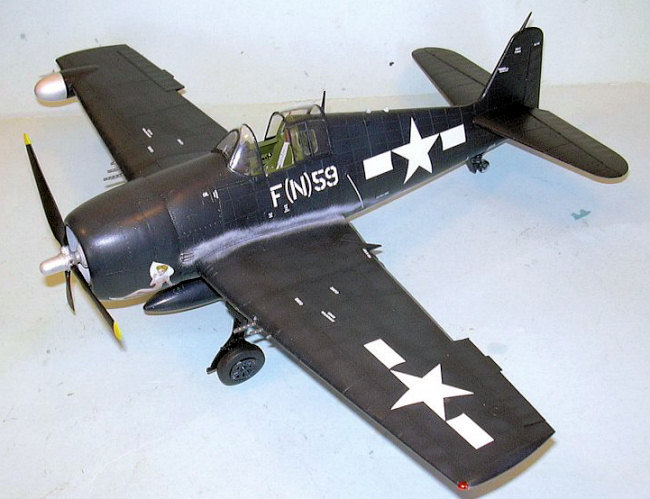
| KIT: | Trumpeter 1/32 F6F-5N |
| KIT #: | 2259 |
| PRICE: | $89.95 DSRP |
| DECALS: | Two options |
| REVIEWER: | Tom Cleaver |
| NOTES: |

| HISTORY |
The F6F‑3/5 Hellcat is the most successful naval fighter series ever built. With pilots of moderate training levels, the airplane could more than hold its own against its opponents, while it was tractable enough that the same moderately‑trained pilot could bring a damaged one back and get aboard his carrier, a point of no small importance in naval warfare. It is the only fighter of the Second World War to remain essentially unchanged in basic design from its introduction to service to its post‑war withdrawal, with the main difference between the two production variants being engine power.
The Myth of the Hellcat:
 To
straighten out the myth of the airplane, the Hellcat was not produced "in
answer" to the Japanese Zero, which would be its major wartime opponent; it
would have been impossible to designan airplane starting in 1942 (following the
discovery of the Zero in the Aleutians that August) that would have had any hope
of getting into production in the required timescale. The Hellcat was already
in preliminary design stages well before the outbreak of the Pacific War, and
first flew about the time of the Battle of Midway. What was indeed fortunate
was that both Grumman and the "Fighter Desk" of the U.S. Navy's Bureau of
Aeronautics had paid attention to what was going on in Europe with regards to
air combat. They guessed right in giving the Hellcat the biggest wing of any
Second World War fighter for maneuverability, and thelargest ammunition
capacity, to improve its ability as a fleet defense fighter. They were
fortunate that the airframe was amenable to initial change from the underpowered
R‑2600 to the far‑superior R‑2800, the finest radial piston engine ever built.
With this engine, the airplane had sufficient power to outfly its opposition.
To
straighten out the myth of the airplane, the Hellcat was not produced "in
answer" to the Japanese Zero, which would be its major wartime opponent; it
would have been impossible to designan airplane starting in 1942 (following the
discovery of the Zero in the Aleutians that August) that would have had any hope
of getting into production in the required timescale. The Hellcat was already
in preliminary design stages well before the outbreak of the Pacific War, and
first flew about the time of the Battle of Midway. What was indeed fortunate
was that both Grumman and the "Fighter Desk" of the U.S. Navy's Bureau of
Aeronautics had paid attention to what was going on in Europe with regards to
air combat. They guessed right in giving the Hellcat the biggest wing of any
Second World War fighter for maneuverability, and thelargest ammunition
capacity, to improve its ability as a fleet defense fighter. They were
fortunate that the airframe was amenable to initial change from the underpowered
R‑2600 to the far‑superior R‑2800, the finest radial piston engine ever built.
With this engine, the airplane had sufficient power to outfly its opposition.
The Hellcat first entered combat in the fall of 1943, as the Navy was beginning the Central Pacific Offensive, with squadrons based aboard both the big "Essex" class fleet carriers, and the "Independence" class light carriers which were based on cruiser hulls. The U.S. Navy was the only air force of the Second World War to insure its fighter pilots went into combat knowing what to do both with their airplanes and their weapons. With this superior gunnery training, many Hellcat pilots became an “ace in a day" in the swirling air battles that began over Truk in early 1944, and then moved on across the Central Pacific with the invasions of the Marshalls and Marianas later that year.
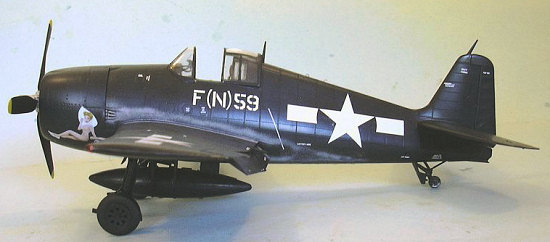 Striking across the breadth of the Pacific against Okinawa, Formosa, Indochina
and the Philippines during the summer and fall of 1944, Hellcats shot down
everything they ran across. From their first introduction into combat in the
summer of 1943 through August 15, 1945, U.S. Navy Hellcats shot down over 5,000
enemy aircraft, and over 300 Hellcat pilots achieved ace status while flying the
airplane. Truly, it was an "ace maker."
Striking across the breadth of the Pacific against Okinawa, Formosa, Indochina
and the Philippines during the summer and fall of 1944, Hellcats shot down
everything they ran across. From their first introduction into combat in the
summer of 1943 through August 15, 1945, U.S. Navy Hellcats shot down over 5,000
enemy aircraft, and over 300 Hellcat pilots achieved ace status while flying the
airplane. Truly, it was an "ace maker."
VMF(N)-541:
“The Bat Eye Squadron” was the first of the eight new Marine nightfighter squadrons commissioned at MCAS Cherry Point in anticipation of the Central Pacific offensive. Commissioned on February 15, 1944 the unit's first C.O. was Major Peter D. Lambrecht, who had been trained in night fighting techniques by the RAF. The units first flew F6F-3Es, with VMF(N)-541 getting the first of the new F6F-5Ns that July. Following the invasion of Peleliu in September 1944, VMF-541 arrived on the island on September 24, 1944. Unfortunately, Japanese aerial opposition had been knocked out, and the unit was left to fly combat air patrols at night that were always negative, while the day fighters engaged in “barge sweeps” against the remaining Japanese in the Palau Islands. Their only aerial success came on October 31, 1944, when Major Norman Mitchell shot down a Jake floatplane over Schonian Harbor, to score the only USMC aerial victory of the Palau campaign.
Following the invasion of the Philippines in October, USAAF P-61 night fighter units were stationed at Tacloban on Leyte, but proved unable to deal successfully with the single engine Japanese fighters that flew dawn and dusk harassment raids. Admiral Halsey informed MacArthur that he had a Marine Air Group that included a night fighter squadron that might be better able to deal with the nimble Ki.43s that provided the bulk of the Japanese threat. VMF(N)-541 arrived at Tacloban on December 3, 1944, flying their first mission - cover for Navy PT boats in Surigao Strait - the night of December 4. On a separate mission that same night, 2ndLt. Rod Montgomery opened the unit's score with the Japanese by shooting down an Oscar just before dawn on December 5.
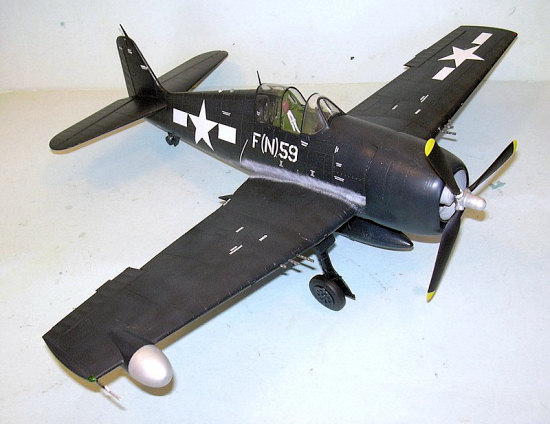 The unit's biggest battle
came on December 12, when a 3-plane “dawn patrol” led by Capt. Dave Thomsen was
vectored onto five groups of Japanese aircraft west of Leyte that totaled 33
aircraft, headed for the convoy they were defending. Four other F6Fs led by 1st
Lt. Fletcher Miller arrived on the scene just as Thomsen's unit made their first
pass through the enemy, knocking down 5. Miller's unit took down 6 in their
pass, and Thomsen came back for another for a total score of 12 in a 10 minute
battle.
The unit's biggest battle
came on December 12, when a 3-plane “dawn patrol” led by Capt. Dave Thomsen was
vectored onto five groups of Japanese aircraft west of Leyte that totaled 33
aircraft, headed for the convoy they were defending. Four other F6Fs led by 1st
Lt. Fletcher Miller arrived on the scene just as Thomsen's unit made their first
pass through the enemy, knocking down 5. Miller's unit took down 6 in their
pass, and Thomsen came back for another for a total score of 12 in a 10 minute
battle.
During the Mindoro landings in late December, VMF(N)-541 scored four more in a 35 minute running battle. VMF(N)-541 was unusual for an American unit in that the pilots included two enlisted NAPs, T/Sgt John Andre and T/Sgt Frank Ratchford. Andre scored his two J2M-3 “Jack” fighters to celebrate the new year. Two more victories were scored by 2nd Lt. Hayes on January 3, to bring the unit's Philippine score to 22. When the unit returned to Peleliu on January 11, 1945, General MacArthur awarded them the Army Distinguished Unit Citation for their efforts, making VMF(N)-541 the only Marine squadron to win the Army award.
After two more unrewarding months at Peleliu, where the unit learned to do night dive-bombing, VMF(N)-541 took their by-then war-weary early Hellcats to Falalop Island in Ulithi Atoll on May 30, 1945, where they replaced VMF(N)-542 and provided night defense for the Navy's Central Pacific fleet anchorage until the end of the war. Faced with declining morale in May, 1945, while the other Marine night fighter squadrons were scoring against the Japanese at Okinawa, VMF(N)-541 became the first Marine unit in the war to officially sanction “nose art,” which adorned their fighters through the summer of 1945.
| THE KIT |
The other 1/32 Hellcat I am aware of is the Hasegawa kit first released in the late 1970s. This kit effectively makes that kit obsolete on any point other than price.
The kit provides superb detail, with fully-detailed engine, accessories, and radio gear within the fuselage that can be seen if a modeler chooses to “open up” the model. The gunbays are fully detailed and the main gear wells have the most detail of any Hellcat in any scale. The cowling is the right shape with the definite “chin” that other manufacturers have missed.
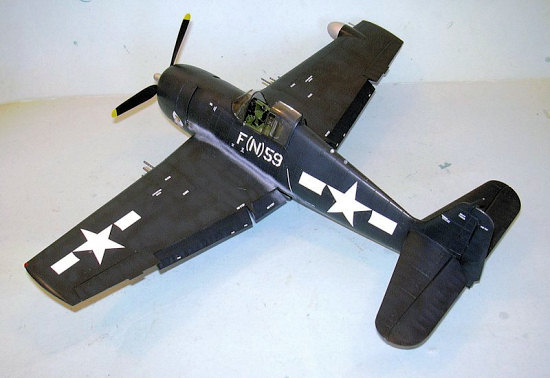 Trumpeter has continued
their policy with US Navy aircraft of providing a model that can be built with
its wings folded. Unlike either the F4F Wildcat or the TBF Avenger kits,
however, Trumpeter has come up with a design for this kit that provides parts
that will allow the wing to have sufficient strength either folded or spread to
stay in its correct position and not be fragile. The system chosen is somewhat
similar to that used by Tamiya for their Corsair and Swordfish, with spars that
go deep into the separate wing areas to provide sufficient strength.
Trumpeter has continued
their policy with US Navy aircraft of providing a model that can be built with
its wings folded. Unlike either the F4F Wildcat or the TBF Avenger kits,
however, Trumpeter has come up with a design for this kit that provides parts
that will allow the wing to have sufficient strength either folded or spread to
stay in its correct position and not be fragile. The system chosen is somewhat
similar to that used by Tamiya for their Corsair and Swordfish, with spars that
go deep into the separate wing areas to provide sufficient strength.
The kit can be built as a “straight” F5F-5, since the radome and 20mm cannon are separate and the instrument panel for the day fighter is provided.
For once, Trumpeter has gotten the decals “good enough” that they can be used. The “white only” US national insignia are the right proportions. The kit provides markings for an F6F-5 from VMF(N)-531 that I think was flown by Bruce Porter, and one from VF(N)-107. There is not much in the way of colorful markings for F6F-5s, but the Marine night fighter does have a nekkid lady on the cowling that is a good decal. One hopes that the aftermarket people will come up with things like the FAA Hellcat II in BPF markings that shot down the last Japanese airplane of World War II, and other interesting markings like the French Aeronavale.
The kit also provides a 1/32 scale tractor or the type used on Navy carriers during the war, which will useful in creating a diorama.
Now then, let's get into the kit's Big Problem, which fortunately has an Easy Solution:
After writing the above review, I did a more extensive study of the Trumpeter
Hellcat, and I have to report that there is something wrong about the kit.
Whether this is a “deal breaker” is for the modeler to decide, but here it is:
somehow, Trumpeter has gotten the cross section of the fuselage around the
cockpit and for about one-third of the distance from the cockpit to the vertical
fin wrong. It is too fat, too wide, and the result is that in this area of upper
fuselage just aft of the cockpit the sides of the fuselage curve outwards in a
way that is very “un-Hellcat-like.” In side profile the model looks all right,
but in head-on profile, the cross section is completely wrong, as it is not the
flat-sided upper fuselage associated with the Hellcat. This makes it look
“squat” in a way the Hellcat just doesn't do. I have reviewed every photo I
have of Hellcats, including some phot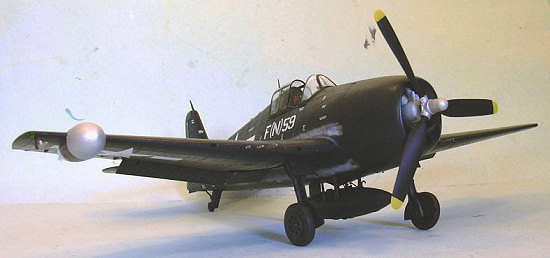 os
I have taken of the two Hellcats out at Chino, and from the 4 o'clock or 8
o'clock positions, this “fatness” that can be so clearly seen in the model from
those angles is nowhere to be seen on the real thing.
os
I have taken of the two Hellcats out at Chino, and from the 4 o'clock or 8
o'clock positions, this “fatness” that can be so clearly seen in the model from
those angles is nowhere to be seen on the real thing.
Fortunately, it turns out this is not “unfixably wrong,” as such a mistake usually is with a kit.
I simply bent and re-shaped the fuselage in the “bulged” area. This is possible since the plastic is soft. Next, one needs to sand the sides of the rear cockpit bulkheads so they have “straight” sides. You will need to “test fit” these to the fuselage after you have re-shaped it.
Finally, the canopy and windshield need re-shaping. I dipped each in just-below-boiling hot water and then “pinched” them to the proper cross-section, then ran them under cold water for a minute to “freeze” the change.
Past that, there are no problems in assembly that I have found, other than some seam-filling for the cockpit and the fuselage just aft of the cockpit to make up for the changes in cross-section shape.
| CONSTRUCTION |
As outlined above, the biggest problem I found in the project was correcting the fuselage shape and the cross section of the canopy and windshield. Once this was accomplished, there was very little else that was complicated.
I also had to make the sway braces for the drop tank. When I realized this, I almost stopped using the tank, since most photos of the airplane I was modeling show it without a tank. However, for the review, I corrected this mistake with Evergreen sheet cut 1/16 inch wide and then cut to fit for length. This was an easy fix, but I fail to understand why Trumpeter missed this, since there are locating holes in the lower fuselage for these items.
 In retrospect, I would
assemble the wings as complete upper and lower sub-assemblies, gluing in the
wing spar firmly to the upper sections before joining them. Since the wing fold
goes through the wheel wells on the Hellcat, there is not much opportunity to
reinforce that joint with evergreen strip inside. By making upper and lower
wings separate initial assemblies, one can work that joint from inside and out
to get it firm. This is really the only difficult part of the “normal” assembly.
In retrospect, I would
assemble the wings as complete upper and lower sub-assemblies, gluing in the
wing spar firmly to the upper sections before joining them. Since the wing fold
goes through the wheel wells on the Hellcat, there is not much opportunity to
reinforce that joint with evergreen strip inside. By making upper and lower
wings separate initial assemblies, one can work that joint from inside and out
to get it firm. This is really the only difficult part of the “normal” assembly.
I also used Cutting Edge flexible resin seatbelts.
For those modelers who may be considering doing the VMF(N)-541 airplane, which is by far the more colorful of the options with its “nekkid lady” on the cowling, I have found photos of this airplane in “Night Wings,” the Squadron-Signal book about Marine night fighter squadrons, that shows this was an early F5F-5, with the rear windows, and an armament of six machine guns. It's easy to modify the kit to this standard, since the rear windows are molded in on the inside of the fuselage and six machine gun barrels are provided, so you do not use the 20mm cannon. Additionally, while this airplane did have the bomb racks, it did not have the rocket rails.
I cut out the rear view windows and modify the rear cockpit bulkhead, which was not difficult, and mounted the six machine guns.
| COLORS & MARKINGS |
Painting:
Once
the model was assembled, I painted it overall with Xtracrylix Glossy Sea Blue,
except for the cone of the radome, which was painted with Tamiya Flat Aluminum
since it was not metal. The nice thing about this par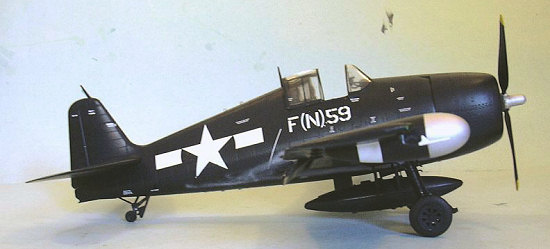 ticular
airplane as a subject is that by the time the nose art was applied in May 1945,
it had been in the Central Pacific since October 1944, so it does indeed have a
sun-faded and salt-air corroded Glossy Sea Blue finish, with lots of exhaust
staining. I added in a bit of grey and went back ov
ticular
airplane as a subject is that by the time the nose art was applied in May 1945,
it had been in the Central Pacific since October 1944, so it does indeed have a
sun-faded and salt-air corroded Glossy Sea Blue finish, with lots of exhaust
staining. I added in a bit of grey and went back ov er
the upper surfaces of the model, “blotching” it with this lighter color.
Unfortunately, it's so subtle that you can only see it when I overexposed the
shots of it painted, but in person in good light, it is more noticeable. (But
still subtle!) I finished off with a coat of Xtracrylix Gloss Varnish.
er
the upper surfaces of the model, “blotching” it with this lighter color.
Unfortunately, it's so subtle that you can only see it when I overexposed the
shots of it painted, but in person in good light, it is more noticeable. (But
still subtle!) I finished off with a coat of Xtracrylix Gloss Varnish.
Markings:
I used the kit decals, which went down without problem, though I had to separate the stars and bars on the wing insignia since Trumpeter had printed them with the top edge of the bars lower than the top line of each “arm” of the star. The decals went down without problem under a coat of Micro-Sol, and proved to be nicely opaque, an important point when putting white decals on over a dark surface.
| FINAL CONSTRUCTION |
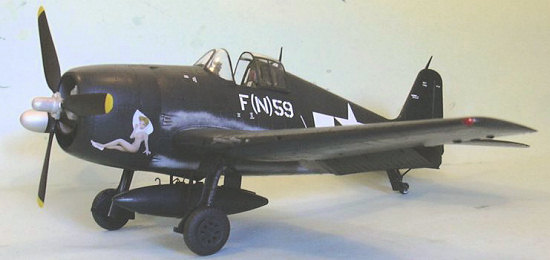 I gave the model an
overall coat of Xtracrylix Satin Varnish, then went over the upper surfaces of
the wings and horizontal stabilizers with Xtracrylix Flat Varnish, which I also
applied to the upper regions of the fuselage and the vertical fin, to simulate
the effects of sun fading. The photos I have show this airplane with heavy grey
exhaust staining, which I did with Tamiya “Sky Grey.” Surprisingly, there do
not seem to be many (if any) dings; this is testament to the hardy nature of
Glossy Sea Blue and good maintenance by the ground crews, since bare aluminum
exposed to salt air on a Central Pacific island would result in rapid
corrosion. Thus, there are no “dings” and the propeller hub is painted with
Tamiya Flat Aluminum, since it was painted with silver lacquer on the real thing
and not left “natural metal.” I attached the flame dampers to the exhausts, and
the navigation lights.
I gave the model an
overall coat of Xtracrylix Satin Varnish, then went over the upper surfaces of
the wings and horizontal stabilizers with Xtracrylix Flat Varnish, which I also
applied to the upper regions of the fuselage and the vertical fin, to simulate
the effects of sun fading. The photos I have show this airplane with heavy grey
exhaust staining, which I did with Tamiya “Sky Grey.” Surprisingly, there do
not seem to be many (if any) dings; this is testament to the hardy nature of
Glossy Sea Blue and good maintenance by the ground crews, since bare aluminum
exposed to salt air on a Central Pacific island would result in rapid
corrosion. Thus, there are no “dings” and the propeller hub is painted with
Tamiya Flat Aluminum, since it was painted with silver lacquer on the real thing
and not left “natural metal.” I attached the flame dampers to the exhausts, and
the navigation lights.
| CONCLUSIONS |
Yes, Trumpeter should have “gotten it right” from the beginning for a shape like the Hellcat, but with only a moderate application of “some modeling skill required,” the result will be a very good model. Some people say the cockpit area is too wide. If so, this is not something that can be fixed, but the “manual modification” of the fuselage halves will change the cross section so it looks close enough to right (assuming it might be wrong) as to satisfy most modelers - it is, as they say, “close enough.” Comparing the model with the two real Hellcats out at Planes of Fame, it looks very convincing indeed and looks good sitting next to my Wildcat and Avenger.
Review kit courtesy of Stevens International.
September 2007
If you would like your product reviewed fairly and quickly by a site that has 400,000 visitors a month, please contact me or see other details in the Note to Contributors.